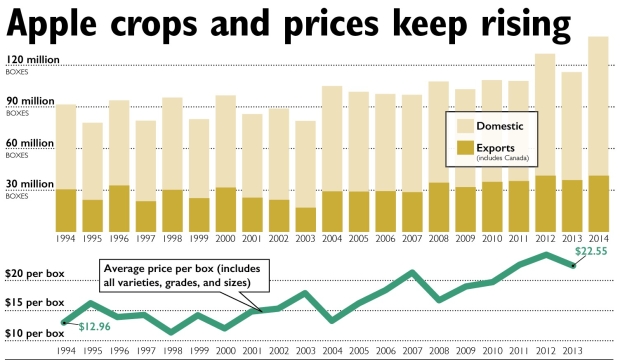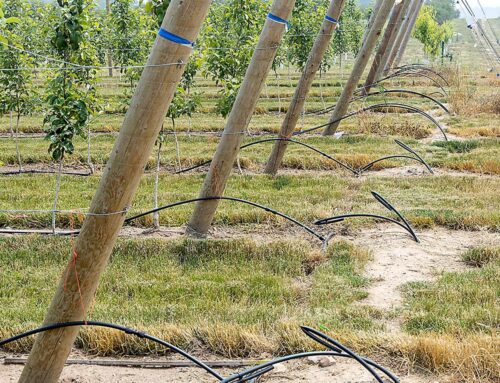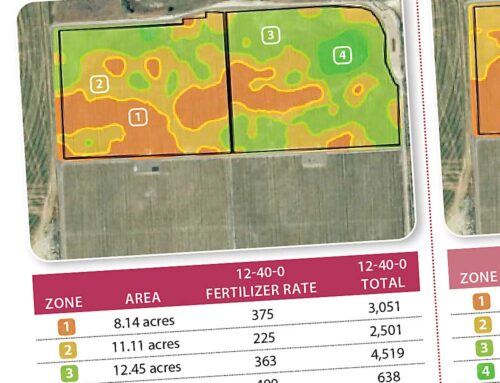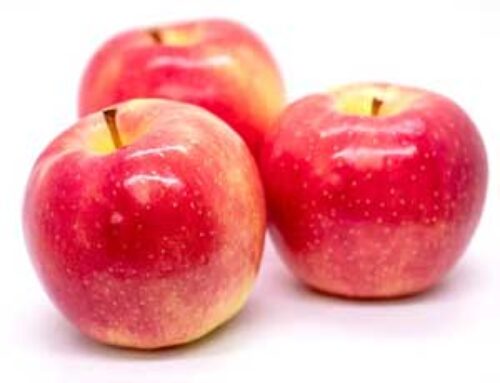
Prices for Washington apples have stayed strong as volumes increase. The state exports about a third of its crop. Source: Washington Apple Commission, Washington Growers Clearing House Association, and Washington State Tree Fruit Association. (Jared Johnson/Good Fruit Grower illustration)
It’s been a decade since the Washington Apple Commission ended its domestic promotion program, after working for more than 60 years to establish Washington apples as “the world’s finest.”
Even without the promotions, apple growers enjoyed a run of profitable years, until the dismal 2014–2015 marketing season.
Last fall, Washington growers harvested a record 150 million boxes of apples, many of which have been dumped or sold below the cost of production because of difficulties in exporting apples and a saturated domestic market.
Washington fruit broker Tom Farris believes the reason growers had so many successful years was they were riding on the lingering reputation of the Washington brand.
“One of the things I’m concerned about is we’ve been living off our past promotional dollars, and now the Washington apple logo is becoming less and less recognized,” said Farris, who is based in Port Angeles, Washington. “The Washington apple logo was probably one of the most recognized logos in America when we had the Apple Commission. It’s kind of like Nike taking the ‘swoosh’ off their products.”
U.S. consumers today don’t care if they buy Michigan, New York, or New Zealand apples, Farris said.
“We need to be getting point-of-purchase material in the stores and make consumers aware that they need to be buying Washington State apples.”
Until 2003, the Apple Commission ran promotions in both domestic and export markets and had a team of regional managers visiting retailers across the United States.
“What we had was a unified marketing effort to help the shippers move the product that was difficult to move,” Ferris said. “The Apple commission played a significant role in continuing to keep Washington State apples on the rack for longer periods of time. Since the Apple Commission dropped its domestic promotions, shippers and marketers have been promoting their individual brands to retailers.”
Exports
The settlement of a lawsuit that the commission initiated (to test the constitutionality of its 25-cents-per-box mandatory assessment) resulted in its domestic program being dropped. However, it has continued to collect a grower assessment of 3.5 cents a box for its export promotion program.
Traditionally, Washington has exported about a third of its apple crop. In 2012, when the state produced
its previous bumper crop of 128 million boxes, a record 40 million boxes (31 percent of the total) were exported.
But last season, Washington apple producers faced a number of marketing difficulties. The China market was closed for part of the season, then a slow-down at West Coast ports limited access to overseas markets during four peak shipping months. And a strong dollar made U.S. apples more expensive overseas.
By the end of June this year, the industry had exported 42.3 million boxes overseas, about 6 million boxes more than at the same time during the 2012-2013 season but short of what Todd Fryhover, president of the Washington Apple Commission had been counting on. He had set a target of at least 50 million boxes for the year.
But Farris believes the export difficulties were not the main issue.
“The big problem is that we need more consumption of apples,” he said. “I don’t know how to market this increased production, but if we think it’s going to have to be offshore, we’re setting ourselves up for disappointment. Right now, we’re only moving about 40 million boxes offshore and we have 150 million.”
Though the 2015 crop will be down from last year’s, reports suggest it could match the 2012 crop.
Think tank
Farris suggests that the industry set up a think tank to look into the possibility of creating a unified domestic promotion program to bring all Washington apples under the same brand—just as it did when the Apple Commission was created back in the 1930s.
“What we want to do is give the Apple Commission a chance to see what they can do with 10 cents a box so we have a way to rebuild the brand,” he said. “Maybe it’s not going to be the entire industry, but a large enough group of people so we can try to identify it as a branded apple from Washington State.”
Otherwise, all that the industry can do is hope it gets lucky with another disaster like the one that almost wiped out the apple crop in competing Midwest and Eastern United States when Washington had its big crop three years ago, he said.
Unless there’s a reduction in production of certain varieties or an increase in demand, he’s concerned that there’ll be a loss of growers and another round of consolidation, with the players with the deeper pockets hoping to ride out the storm.
Fryhover sees hope for increasing apple consumption, as apples have several attributes that align with today’s consumer preferences. They are a healthy and nutritious snack that can help fight obesity, and they come in a wider range of varieties than ever before, with new tastes and textures.
He thinks a joint effort to promote Washington apples could have some impact, but he doubts there’s a will to do it.
“We need one organization that’s focused on building demand in the domestic market, but I don’t see our industry moving in that direction,” he said. “They seem to be moving away from that. When we had 4,000 growers, I think the industry was more focused on the group because we were very diversified.
“But it seems to me that the trend is towards consolidation, and that doesn’t necessarily support group effort,” he said. “It seems like the more control these larger shippers have, the more concentration they have on their own brand, and I can’t argue with that from an individual shipper viewpoint.”
A voluntary promotion program to boost apple consumption could only be successful if most of the Washington marketers participated, he believes.
Brand
But Fryhover agrees that without a renewed promotion effort the Washington brand will be forgotten.
“The work that’s been done to build the brand in the past has maintained awareness over the years since 2003, but every year we’re not supporting that through some sort of activity, we’re eroding that brand and it will eventually disappear,” he said. “When people think about apples in the U.S., generally they think about Washington, but there’s a new generation of consumers and they don’t know us.”
Several years ago, a survey of shippers showed that 60 to 70 percent were using the Washington apple
logo on their apple stickers. Fryhover thinks the percentage is probably slipping as packers use the limited space on the stickers to promote their own exclusive varieties.
Randy Steensma, general manager of Honey Bear Tree Fruit Company, Wenatchee, said he supports the idea of a Washington promotion program.
“Buyers look to Washington for Washington apples,” he said. “They don’t look to Washington for a private label. With that dominance of the Washington theme, it would make sense to promote that Washington theme again and promote that the best apples in the world are grown in Washington.”
However, Steensma said many shippers have merchandising teams out visiting retailers to promote their own labels, and he does not see that ending.
“Would you do both?” he wondered. “Would you still provide your own label and hit the Washington theme that still resonates with people?”
He thinks marketers would be reluctant to go back to a 25-cents-per box assessment, because they probably think they can use that money more effectively in house, but they might support a reduced assessment of, say, 3 to 5 cents a box, which would generate $4.5 to $7.5 million on a 150-million box crop.
Buy local
Dain Craver, an organic grower at Royal City, said he was opposed to ending the Washington Apple Commission’s domestic program but is not sure now if it should be reinstated.
“I could see that a broker would want to bring them back in because he doesn’t have the money to promote apples, whereas the marketing companies, they’re putting their own money into advertising,” he said.
“As we’ve gotten into this for the past few years, actually I think the marketing agencies are doing a pretty good job. In retrospect, I don’t know if it would be a good idea any more with everyone wanting to buy local—that’s one of the trends. If you’re promoting the Washington apple, the people on the East Coast may not find that attractive.”
When Red Delicious was the No. 1 apple variety, Washington could claim to be the best place on earth to grow the variety, but that’s not necessarily so with the newer varieties.
“I love the Washington logo,” Craver said. “I still have stickers all over the place. But from the marketing end, I don’t know if it would help or hurt us.” •






Leave A Comment